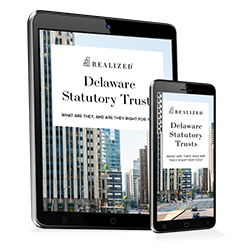
Entering a Delaware Statutory Trust (DST) as part of your 1031 Exchange strategy is a great way to preserve your capital gains and diversify your portfolio. This can help investors defer capital gains taxes while gaining access to institutional-grade real estate. However, even though you may defer capital gains taxes, a DST does not eliminate all tax obligations. There are still other obligations you’ll need to address to avoid IRS scrutiny, penalties, and possible removal of your tax-deferred status.
Realized 1031 has shared a guide on Delaware Statutory Trust reporting to help you understand the necessary steps and areas to cover. That way, you can be more confident about your reports once filing season comes. Let’s dive in.
Understanding Taxation in DSTs
To grasp how taxation works in DSTs, let us first review the DST structure. A DST is an investment vehicle where investors own fractional interests. The trust, in turn, owns the DST property. In other words, there is no direct ownership. Thanks to this structure, DSTs are considered pass-through entities. The trust doesn’t pay any corporate income taxes. Instead, the income and expenses generated by the trust are passed directly to investors, who must report them on their individual tax returns.
What types of tax considerations emerge from such a structure? Here are some of what you can expect.
- Income Reporting: Investors typically receive either Form 1099 (for grantor trust structures) or a Schedule K-1 (for partnership structures), detailing their share of rental income, deductions, and depreciation.
- Depreciation Benefits: Investors can use depreciation deductions to offset taxable income, reducing their tax liability. These will still need to be reported.
- Capital Gains Tax: When the DST sells properties, investors may owe capital gains tax and depreciation recapture.
How DST Sponsors Handle Tax Reporting
DST sponsors are the parties that handle the administration and day-to-day management of DSTs. The sponsor’s role also extends to tax documentation and compliance for investors. Depending on how the DST is structured, investors typically receive either Form 1099 or a Schedule K-1, which details each investor’s share of income, deductions, and depreciation. Sponsors also track property depreciation and allocate tax benefits accordingly.
When the DST property is sold, the sponsor reports the sale to investors and provides the necessary documentation for their own tax reporting. However, investors are responsible for coordinating any 1031 Exchange activity with a qualified intermediary and their tax professionals to meet IRS requirements. Sponsors must follow federal and state tax regulations when issuing investor tax documents.
Reporting Income From DSTs
There are many ways a DST can earn income. These earnings are generally reportable for tax purposes and must be included in your federal income tax return.
DST properties generate monthly rental revenue, which is distributed to investors proportionally. This income is reported on Schedule E (Supplemental Income and Loss) of Form 1040. Meanwhile, interest income from financing-related investments is reported separately on Schedule B (Interest and Ordinary Dividends).
What about deductions? These expenses can help reduce income and, by extension, the tax obligation. These will typically be included in the tax reporting documents form from the sponsor. Common deductions include the following.
- Property management fees
- Maintenance and operating expenses
- Mortgage interest (if applicable to the DST’s structure)
- Other expenses as listed on the tax reporting documents
Reporting Depreciation From DSTs
The IRS allows investors a pass-through deduction on the DST property to account for the expected wear and tear of the asset. Depreciation can be used to offset income by deducting a portion of the property’s value over time. Depreciation is calculated using the Modified Accelerated Cost Recovery System (MACRS). Investors receive their allocated depreciation deductions on their tax reporting documents.
One thing you have to consider is depreciation recapture, which happens if you sell the asset at a profit while following the adjusted basis after depreciation. The recaptured amount will be taxed at ordinary income rates, eating a significant amount of your capital in some cases.
Capital Gains Tax Considerations for DST Investors
There are two common ways you may need to pay capital gain taxes in a DST investment. First is when the DST property is sold after the holding period. Any profit will be taxed at capital gains rates — the highest at 20%. Additionally, high-income investors may be subject to the 3.8% Net Investment Income Tax (NIIT).
The other scenario is when you take out funds from the proceeds of a 1031 Exchange sale before entering the DST. This practice is allowed, but any non-like-kind property you receive will be considered boot and is taxable.
Capital gains are typically reported on Schedule D (Form 1040), with transaction details listed on Form 8949.
What Tax Professionals Need to Consider for DST Clients
During DST tax reporting, it’s best practice to work with tax professionals like accountants to ensure accuracy with the information. Here are a few considerations to ask your tax professional to cover all your bases.
- Grantor Letters, 1099s, or K-1s: Work with your accountant to prepare or review your Schedule E, ensuring accurate reporting of income, deductions, and depreciation. These documents typically provide essential information for tax reporting related to passive real estate investments, such as DSTs, REITs, or other partnership interests. By cross-referencing these tax forms with Schedule E, your accountant can help confirm the consistency of reported income, property expenses, and depreciation schedules, which is critical to minimizing errors or audits.
- Depreciation Recapture: When DST properties are sold, depreciation recapture may apply, and tax professionals should help clients plan for potential tax liabilities. This tax provision requires investors to pay taxes on prior depreciation deductions at the time of a property's sale, often at a higher rate than capital gains. Proactively evaluating the potential impact of recapture and incorporating it into long-term planning—especially when exiting a DST or executing a 1031 Exchange—can help clients avoid unexpected tax burdens and preserve more of their investment proceeds.
- State Laws: The processes and rules we outlined above only apply at the federal level. Investors must still follow state laws, and accountants can help you understand local tax implications.
- 1031 Exchanges: If you’re entering a DST through a 1031 Exchange, make sure that you’re working with a tax professional who understands the complex considerations involved in this tax-deferral strategy.
Wrapping Up: Basics of DST Tax Reporting
Accurate and timely reporting is critical in DSTs, especially for investors who entered this type of investment through a like-kind exchange. Leverage the guide we shared above to learn about your tax obligations, the process, and the forms involved during reporting to eliminate errors and maintain your tax-deferred status.
The tax and estate planning information offered by the advisor is general in nature. It is provided for informational purposes only and should not be construed as legal or tax advice. Always consult an attorney or tax professional regarding your specific legal or tax situation.
Article written by: Story Amplify. Story Amplify is a marketing agency that offers services such as copywriting across industries, including financial services, real estate investment services, and miscellaneous small businesses.
Cited Sources:
https://www.investopedia.com/terms/f/flow-through.asp



